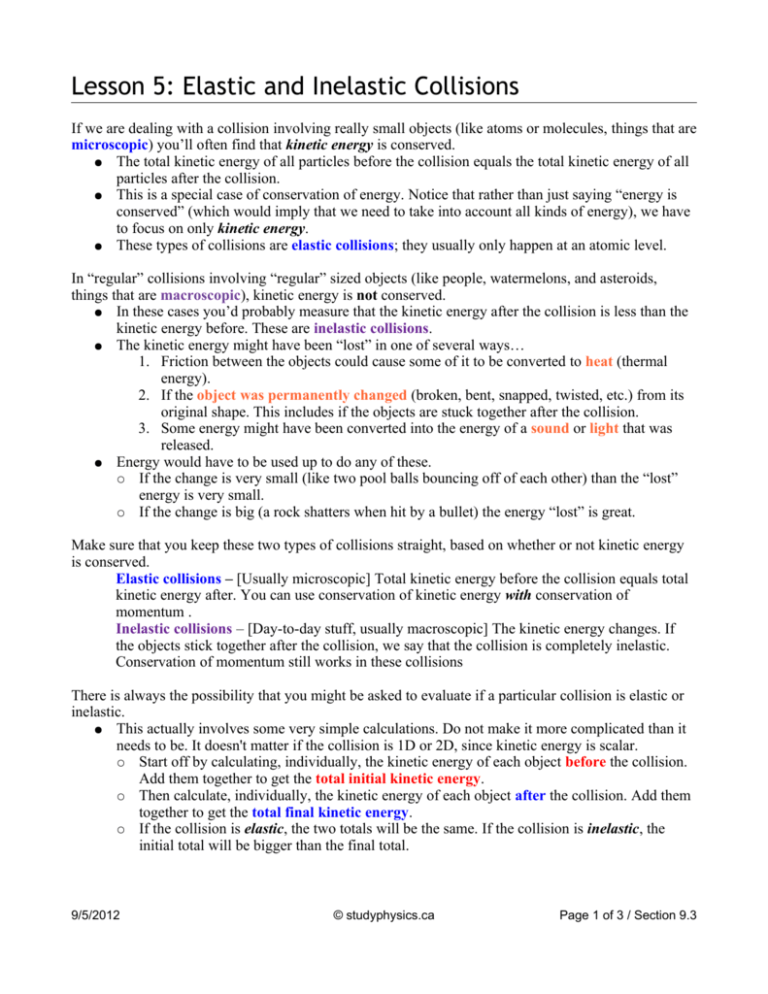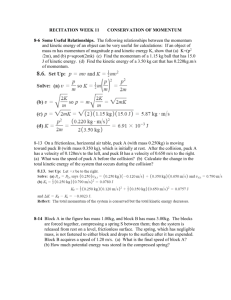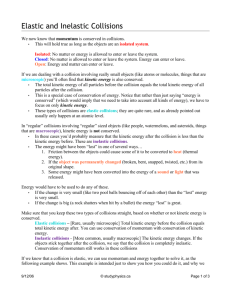Lesson 5: Elastic and Inelastic Collisions
advertisement

Lesson 5: Elastic and Inelastic Collisions If we are dealing with a collision involving really small objects (like atoms or molecules, things that are microscopic) you’ll often find that kinetic energy is conserved. ● The total kinetic energy of all particles before the collision equals the total kinetic energy of all particles after the collision. ● This is a special case of conservation of energy. Notice that rather than just saying “energy is conserved” (which would imply that we need to take into account all kinds of energy), we have to focus on only kinetic energy. ● These types of collisions are elastic collisions; they usually only happen at an atomic level. In “regular” collisions involving “regular” sized objects (like people, watermelons, and asteroids, things that are macroscopic), kinetic energy is not conserved. ● In these cases you’d probably measure that the kinetic energy after the collision is less than the kinetic energy before. These are inelastic collisions. ● The kinetic energy might have been “lost” in one of several ways… 1. Friction between the objects could cause some of it to be converted to heat (thermal energy). 2. If the object was permanently changed (broken, bent, snapped, twisted, etc.) from its original shape. This includes if the objects are stuck together after the collision. 3. Some energy might have been converted into the energy of a sound or light that was released. ● Energy would have to be used up to do any of these. ○ If the change is very small (like two pool balls bouncing off of each other) than the “lost” energy is very small. ○ If the change is big (a rock shatters when hit by a bullet) the energy “lost” is great. Make sure that you keep these two types of collisions straight, based on whether or not kinetic energy is conserved. Elastic collisions – [Usually microscopic] Total kinetic energy before the collision equals total kinetic energy after. You can use conservation of kinetic energy with conservation of momentum . Inelastic collisions – [Day-to-day stuff, usually macroscopic] The kinetic energy changes. If the objects stick together after the collision, we say that the collision is completely inelastic. Conservation of momentum still works in these collisions There is always the possibility that you might be asked to evaluate if a particular collision is elastic or inelastic. ● This actually involves some very simple calculations. Do not make it more complicated than it needs to be. It doesn't matter if the collision is 1D or 2D, since kinetic energy is scalar. ○ Start off by calculating, individually, the kinetic energy of each object before the collision. Add them together to get the total initial kinetic energy. ○ Then calculate, individually, the kinetic energy of each object after the collision. Add them together to get the total final kinetic energy. ○ If the collision is elastic, the two totals will be the same. If the collision is inelastic, the initial total will be bigger than the final total. 9/5/2012 © studyphysics.ca Page 1 of 3 / Section 9.3 Let's figure out a question and then see if it is elastic or inelastic collision. Example 1: One way to test the speed of a bullet shot from a gun is to use a device called a ballistic pendulum. Because it is based on well understood physics, it can give very accurate results even though the equipment is quite simple. A block of material such as wood is hung from supporting wires as shown below. When the bullet is shot at the pendulum, it hits and becomes embedded in the pendulum. Together, the pendulum and the bullet swing upwards. By measuring the maximum height that the pendulum and bullet swing to, the speed of the bullet just before impact can be calculated. For this problem, a 0.0200 kg bullet collides with a 5.7500 kg pendulum. After the collision, the pair swings up to a maximum height of 0.386 m . Determine the velocity of the bullet just before impact. velocity = ? bullet Maximum Height block Illustration 1: A Ballistic Pendulum Part 1: Conservation of Energy We can't use conservation of energy to examine what happened before and after the collision. We can only do that with conservation of momentum. For now, let's just look at what happened after the bullet hit the block, making it swing upwards. We know that the kinetic energy of pendulum-bullet just after the collision is turned into gravitational potential energy as it swings upwards, so... Ek = Ep ½ mv2 = mgh ½ v2 = gh v= 2gh v = 29.810.386 v=2.75 m/s This is the velocity of the pendulum-bullet just after the collision has happened. Part 2: Conservation of Momentum Now we have enough information to use conservation of momentum to examine before and after the collision, which will allow us to calculate the velocity of the bullet just before it hit the pendulum. This is what conservation of momentum is good at... looking at both the before and after parts of a collision. 9/5/2012 © studyphysics.ca Page 2 of 3 / Section 9.3 ptotal = ptotal ' mpvp + mbvb = mpvp' + mbvb' 0 + mbvb = v'(mp+ mb) 0.0200 vb = 2.75 (5.7500 + 0.0200) 0.0200 vb = 2.75 (5.7700) 0.0200 vb = 15.9 vb = 794 m/s The bullet was traveling at 794 m/s just before it hit the pendulum. Example 2: In Example 1 we can assume that the collision was inelastic (since we know it's macroscopic). But let's be careful and check it out mathematically... that's the only way to be certain. Using the information from Example 1, determine if the collision was elastic or inelastic. Initially, only the bullet was moving. We only need to calculate its kinetic energy and use that value as the total initial kinetic energy. 1 2 1 2 E k = mv = 0.0200794 =6304.36 J =6.30e3 J 2 2 Just after the collision, the bullet and the block move together as one mass at the same velocity. We'll only need to do one calculation for the total final kinetic energy. 1 1 E k = mv2 = 5.77002.752=21.8178125 J =21.8 J 2 2 It's obvious that after the collision there is considerably less kinetic energy than at the start. This is an inelastic collision. In fact, only about 0.346% of the kinetic energy remained after the collision. To get the percentage, just divide the final by the initial. Homework p482 #1, 2 p484 #2 9/5/2012 © studyphysics.ca Page 3 of 3 / Section 9.3







